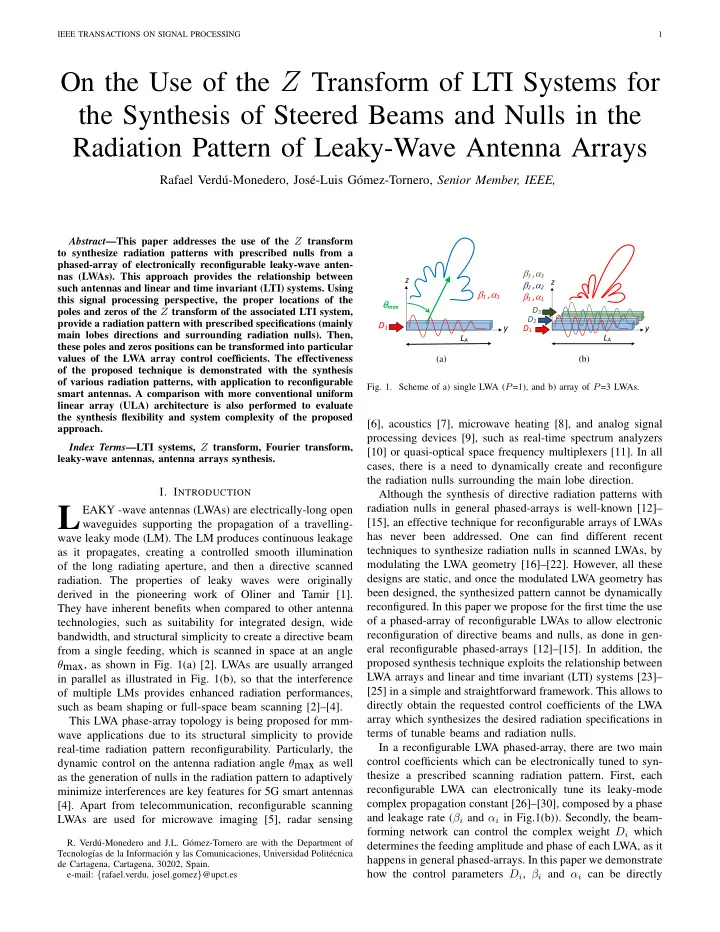

IEEE TRANSACTIONS ON SIGNAL PROCESSING 1 On the Use of the Z Transform of LTI Systems for the Synthesis of Steered Beams and Nulls in the Radiation Pattern of Leaky-Wave Antenna Arrays Rafael Verd´ u-Monedero, Jos´ e-Luis G´ omez-Tornero, Senior Member, IEEE, Abstract —This paper addresses the use of the Z transform to synthesize radiation patterns with prescribed nulls from a phased-array of electronically reconfigurable leaky-wave anten- β α β 3 , α 3 nas (LWAs). This approach provides the relationship between z β α z z β 2 , α 2 such antennas and linear and time invariant (LTI) systems. Using β 1 , α 1 β α β α β 1 , α 1 this signal processing perspective, the proper locations of the θ max θ D 3 poles and zeros of the Z transform of the associated LTI system, D 2 provide a radiation pattern with prescribed specifications (mainly D 1 y D 1 y main lobes directions and surrounding radiation nulls). Then, L A L A these poles and zeros positions can be transformed into particular values of the LWA array control coefficients. The effectiveness (a) (b) of the proposed technique is demonstrated with the synthesis of various radiation patterns, with application to reconfigurable Fig. 1. Scheme of a) single LWA ( P =1), and b) array of P =3 LWAs. smart antennas. A comparison with more conventional uniform linear array (ULA) architecture is also performed to evaluate the synthesis flexibility and system complexity of the proposed [6], acoustics [7], microwave heating [8], and analog signal approach. processing devices [9], such as real-time spectrum analyzers Index Terms —LTI systems, Z transform, Fourier transform, [10] or quasi-optical space frequency multiplexers [11]. In all leaky-wave antennas, antenna arrays synthesis. cases, there is a need to dynamically create and reconfigure the radiation nulls surrounding the main lobe direction. I. I NTRODUCTION Although the synthesis of directive radiation patterns with radiation nulls in general phased-arrays is well-known [12]– L EAKY -wave antennas (LWAs) are electrically-long open [15], an effective technique for reconfigurable arrays of LWAs waveguides supporting the propagation of a travelling- has never been addressed. One can find different recent wave leaky mode (LM). The LM produces continuous leakage techniques to synthesize radiation nulls in scanned LWAs, by as it propagates, creating a controlled smooth illumination modulating the LWA geometry [16]–[22]. However, all these of the long radiating aperture, and then a directive scanned designs are static, and once the modulated LWA geometry has radiation. The properties of leaky waves were originally been designed, the synthesized pattern cannot be dynamically derived in the pioneering work of Oliner and Tamir [1]. reconfigured. In this paper we propose for the first time the use They have inherent benefits when compared to other antenna of a phased-array of reconfigurable LWAs to allow electronic technologies, such as suitability for integrated design, wide reconfiguration of directive beams and nulls, as done in gen- bandwidth, and structural simplicity to create a directive beam eral reconfigurable phased-arrays [12]–[15]. In addition, the from a single feeding, which is scanned in space at an angle proposed synthesis technique exploits the relationship between θ max, as shown in Fig. 1(a) [2]. LWAs are usually arranged LWA arrays and linear and time invariant (LTI) systems [23]– in parallel as illustrated in Fig. 1(b), so that the interference [25] in a simple and straightforward framework. This allows to of multiple LMs provides enhanced radiation performances, directly obtain the requested control coefficients of the LWA such as beam shaping or full-space beam scanning [2]–[4]. array which synthesizes the desired radiation specifications in This LWA phase-array topology is being proposed for mm- terms of tunable beams and radiation nulls. wave applications due to its structural simplicity to provide In a reconfigurable LWA phased-array, there are two main real-time radiation pattern reconfigurability. Particularly, the control coefficients which can be electronically tuned to syn- dynamic control on the antenna radiation angle θ max as well thesize a prescribed scanning radiation pattern. First, each as the generation of nulls in the radiation pattern to adaptively reconfigurable LWA can electronically tune its leaky-mode minimize interferences are key features for 5G smart antennas complex propagation constant [26]–[30], composed by a phase [4]. Apart from telecommunication, reconfigurable scanning and leakage rate ( β i and α i in Fig.1(b)). Secondly, the beam- LWAs are used for microwave imaging [5], radar sensing forming network can control the complex weight D i which R. Verd´ u-Monedero and J.L. G´ omez-Tornero are with the Department of determines the feeding amplitude and phase of each LWA, as it Tecnolog´ ıas de la Informaci´ on y las Comunicaciones, Universidad Polit´ ecnica happens in general phased-arrays. In this paper we demonstrate de Cartagena, Cartagena, 30202, Spain. how the control parameters D i , β i and α i can be directly e-mail: { rafael.verdu, josel.gomez } @upct.es
Recommend
More recommend